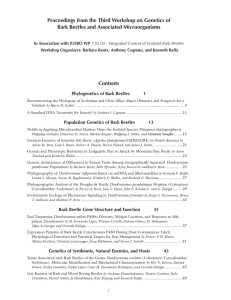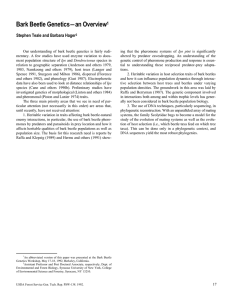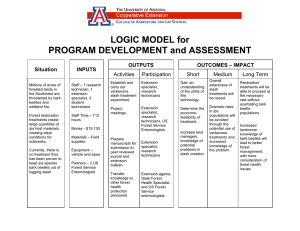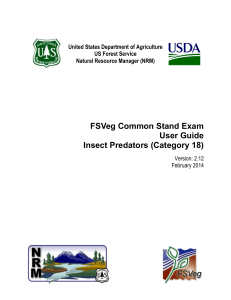B Bark Beetles
advertisement
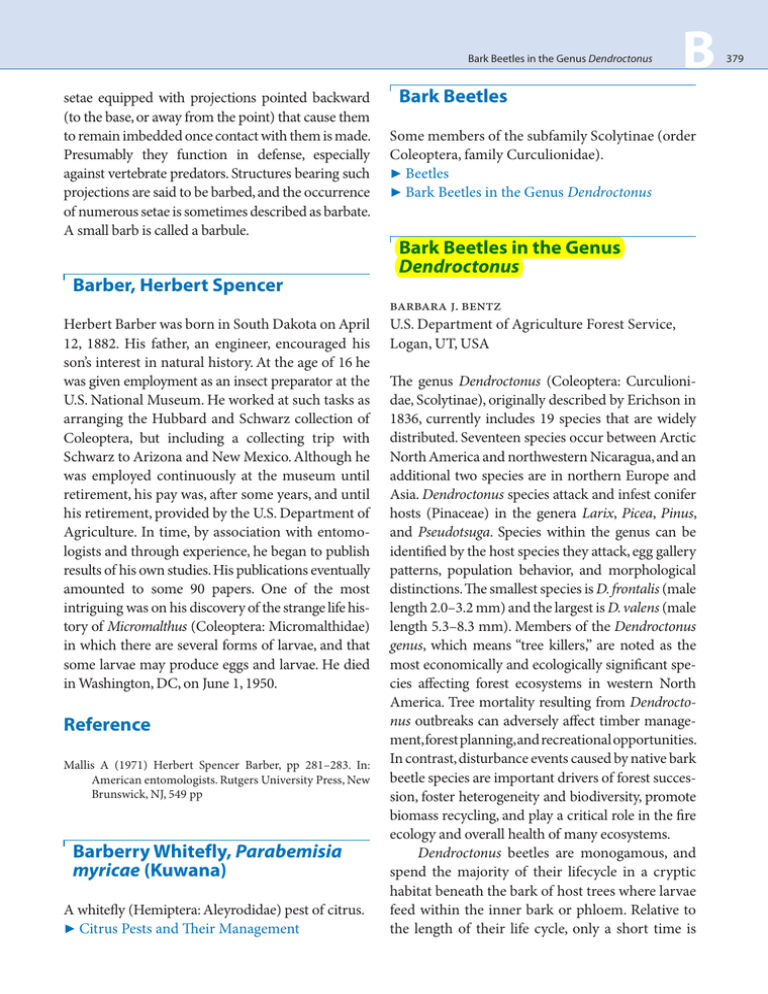
Bark Beetles in the Genus Dendroctonus setae equipped with projections pointed backward (to the base, or away from the point) that cause them to remain imbedded once contact with them is made. Presumably they function in defense, especially against vertebrate predators. Structures bearing such projections are said to be barbed, and the occurrence of numerous setae is ­sometimes described as barbate. A small barb is called a barbule. Barber, Herbert Spencer Herbert Barber was born in South Dakota on April 12, 1882. His father, an engineer, encouraged his son’s interest in natural history. At the age of 16 he was given employment as an insect preparator at the U.S. National Museum. He worked at such tasks as arranging the Hubbard and Schwarz ­collection of Coleoptera, but including a collecting trip with Schwarz to Arizona and New Mexico. Although he was employed continuously at the museum until retirement, his pay was, after some years, and until his retirement, provided by the U.S. Department of Agriculture. In time, by association with entomo­ logists and through experience, he began to ­publish results of his own studies. His publications eventually amounted to some 90 papers. One of the most intriguing was on his ­discovery of the strange life history of Micromalthus (Coleoptera: Micromalthidae) in which there are several forms of larvae, and that some larvae may produce eggs and larvae. He died in Washington, DC, on June 1, 1950. Reference Mallis A (1971) Herbert Spencer Barber, pp 281–283. In: American entomologists. Rutgers University Press, New Brunswick, NJ, 549 pp Barberry Whitefly, Parabemisia myricae (Kuwana) A whitefly (Hemiptera: Aleyrodidae) pest of citrus. Citrus Pests and Their Management B Bark Beetles Some members of the subfamily Scolytinae (order Coleoptera, family Curculionidae). Beetles Bark Beetles in the Genus Dendroctonus Bark Beetles in the Genus Dendroctonus barbara j. bentz U.S. Department of Agriculture Forest Service, Logan, UT, USA The genus Dendroctonus (Coleoptera: Curculionidae, Scolytinae), originally described by Erichson in 1836, currently includes 19 species that are widely distributed. Seventeen species occur between Arctic North America and northwestern Nicaragua, and an additional two species are in northern Europe and Asia. Dendroctonus species attack and infest conifer hosts (Pinaceae) in the ­genera Larix, Picea, Pinus, and Pseudotsuga. ­Species within the genus can be identified by the host ­species they attack, egg gallery patterns, population behavior, and morphological distinctions. The smallest ­species is D. frontalis (male length 2.0–3.2 mm) and the largest is D. valens (male length 5.3–8.3 mm). ­Members of the Dendroctonus genus, which means “tree killers,” are noted as the most economically and ecologically significant species affecting forest ecosystems in western North America. Tree ­mortality resulting from Dendroctonus outbreaks can adversely affect timber management, forest planning, and recreational opportunities. In contrast, disturbance events caused by native bark beetle species are important drivers of forest succession, foster heterogeneity and biodiversity, promote­ ­biomass recycling, and play a critical role in the fire ecology and overall health of many ecosystems. Dendroctonus beetles are monogamous, and spend the majority of their lifecycle in a cryptic habitat beneath the bark of host trees where larvae feed within the inner bark or phloem. Relative to the length of their life cycle, only a short time is 379 380 B Bark Beetles in the Genus Dendroctonus spent as an adult moving from tree to tree. The majority of the species in this genus is capable of killing the host tree in one generation. In fact, death of the host is often a requirement for successful brood production. Although most of the species are capable of attacking and killing standing, ­vigorous trees, recently fallen trees are favored by some species. The female is the colonizing sex in the majority of Dendroctonus species. After attack of a new host, mating typically occurs in a nuptial chamber beneath the bark and an egg gallery is ­initiated. Adults of a few species, however, mate before emerging from the brood host. Eggs are laid either singly along the sides of the gallery, or in clumps. Egg galleries may be either vertical or ­sinuous, and larvae mine and feed horizontally in the phloem, either singly or en mass, depending on the species. Pupation takes place in individual niches within the phloem or in the outer bark of the host tree. Upon adult emergence, which is usually ­temperature dependent, beetle dispersal to a new host occurs and the process begins again. Aggregation, which facilitates host selection and mating, is an important life history strategy of most, although not all, Dendroctonus species. Aggregation is often a response to chemicals ­produced by the host tree, adults from the same or a different species attacking the host tree, microbes, or a combination of these factors. Aggregation on a single host tree allows for a mass attack by ­conspecific beetles, thereby overcoming the resin defensives of the conifer hosts. To overcome the defenses of healthy, vigorous hosts, many beetles must attack within a short time (1–3 days). Conversely, trees of poor health may be overcome by fewer beetles (e.g., endemic population levels). Because a single tree is a limited resource, some Dendroctonus species have evolved a response to a series of chemicals that interrupt aggregation. These chemicals act to space beetle attacks along a single tree and signal incoming beetles to begin attack on another, nearby tree. Synthetic forms of both attractive and interruptive aggregation chemicals have been developed for many Dendroctonus species. The attractive aggregant chemical(s) are commonly used, often with traps, for monitoring and control of many economically important ­species in the genus. The complexity of the signal for interruption of aggregation has made it difficult to identify the chemical makeup of compounds, as well as, the specific biological action of the ­compounds within the population ecology of many Dendroctonus species. Consequently, the current use of synthetic interruptive aggregation chemicals is limited. As with most poikilothermic organisms, temperature is a strong driving force of Dendroctonus population dynamics and an important controller of seasonality. Diapause, which is often temperature related, is typically considered the universal adaptation of insects for maintaining seasonality. However, with the exception of an adult reproductive diapause in D. rufipennis and D. pseudotsugae, and a prepupal diapause in D. rufipennis, this physiological timing mechanism appears to be absent in the Dendroctonus genus. Instead, ­Dendroctonus seasonality appears to be under direct temperature control. Life cycle duration in the genus is variable depending on the species, latitude, elevation, and microclimate of the population. Species in the south can have as many as seven ­generations per year, whereas in the north, or at high elevation some species require up to 3 years to ­complete a single generation. Intraspecific lati­tudinal differences in many temperature-­ associated life history traits exist as well. Global climate warming will undoubtedly have significant impacts on the distribution and seasonality of the Dendroctonus species. Many Dendroctonus species carry spores of symbiotic fungi either passively on the exoskeleton or in specialized structures of the integument called mycangia. The fungi are disseminated among host trees via adult Dendroctonus beetles. Although little research has been conducted on fungal associations of the majority of Dendroctonus species, the work that has been done shows both a benefit and a detriment to the beetle, depending on the particular fungal associate. ­Benefits gained include protecting the beetle brood Bark-Lice, Book-Lice or Psocids (Psocoptera) from other antagonistic associates, aiding beetles in overcoming host tree defenses through pathogenic action of the fungi, altering the moisture composition of the phloem, and providing or ­concentrating nutrients essential for reproduction or development. Native Dendroctonus bark beetles play significant roles in long term forest ecosystem function and structure. However, forest conditions in many parts of the Dendroctunus range in North America have changed from conditions that existed prior to pre-European colonization. The result is large ­landscapes vulnerable to Dendroctonus outbreaks which are often in conflict with current land use objectives. The formulation of effective management strategies for Dendroctonus populations requires careful consideration of all aspects of land use including timber production, the urban/wildland interface, wilderness, watershed, recreation and wildlife. Synthetic attractive and interruptive ­aggregation chemicals and silvicultural options are available for some species to aid in the prevention and suppression of large scale outbreaks. Any action, including no action, should be tightly tied to the management objectives for the landscape under ­consideration. Restoration of the landscape to reestablish ecological integrity after an outbreak is also important for maintaining long-term ­ecosystem health. Mountain Pine Beetle Douglas-Fir Beetle Roundheaded Pine Beetle References Coulson RN, Witter JA (1984) Forest entomology, ecology and management. Wiley, New York, NY, 669 pp Mitton JB, Sturgeon KB (1982) Bark beetles in North ­American conifers, a system for the study of evolutionary biology. University of Texas Press, Austin, TX Schowalter TD, Filip GM (1993) Beetle-pathogen interactions in conifer forests. Academic Press, London, UK. 252 pp Samman S, Logan J (2000) Assessment and response to bark beetle outbreaks in the rocky mountain area. Report to Congress from Forest Health Protection Washington B Office, Forest Service, U.S. Department of Agriculture. USDA Forest Service, Rocky Mountain Research ­Station, General Technical Report RMRS-GTR-62 Seybold SJ, Bohlmann J, Raffa KF (2000) Biosynthesis of coniferophagous bark beetle pheromones and conifer isoprenoids: evolutionary perspective and synthesis. Can Entomol 132:697–753 Wood SL (1982) The bark and ambrosia beetles of North and Central America (Coleoptera: Scolytidae), a taxonomic monograph. Great Basin Naturalist Memoirs, Number 6 Brigham Young University Provo, UT, 1359 pp Bark-Gnawing Beetles Members of the family Togossitidae (order Coleoptera). Beetles Bark-Lice, Book-Lice or Psocids (Psocoptera) arturo baz Universidad de Alcalá, MadridSpain The insects of the order Psocoptera (=Copeognatha, Corrodentia) are commonly called psocids, although outdoor species living on tree trunks and branches have been called bark-lice, whereas indoor species, sometimes found in old books, have been called book-lice. The Psocoptera are a small order of paraneopteran insects (near 4,000 species have been described around the world) which are found in a wide range of terrestrial ecosystems throughout the world. Most psocids inhabit trees and shrubs, some others occur in ground litter, others are found on rocks and in the nests of birds and mammals. Some live on herbs and grasses, and a few in moss, whereas others are found in caves. Lastly, several species are found in domestic habitats. The Psocoptera share certain morphological features with the lice (orders Mallophaga and Siphunculata; Phthiraptera of some authors), and these taxa are grouped together in the superorder Psocodea by some authors. Fossil insects identified as psocids have been reported 381
